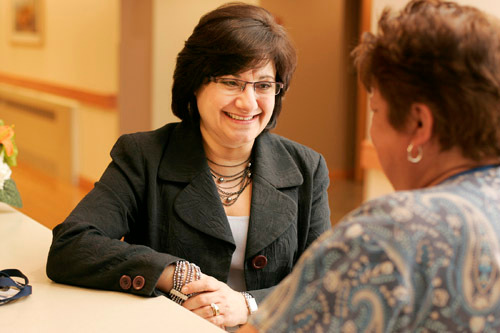
When most people picture CEOs, they think of suit-sporting corporate types locked away in fancy offices crunching numbers. And in many cases, that image holds true to life. But if you’re talking about Diana Franchitto, the CEO and president of Home & Hospice Care of Rhode Island, that stereotype couldn’t be further from reality.
While her days surely involve financial management (and about every other kind of management), Franchitto makes time to visit all of the organization’s terminally ill patients who reside at the Philip Huluta Inpatient Center in Providence.
Not only does she interact with patients, she offers support to grieving family members, brings in local musicians to play in hallways and chats warmly with staffers.
“I’ve seen managers of nursing homes who don’t know the names of almost a single patient,” said Stanley Aronson, a physician and one of the founding members of HHCRI. “This woman – she lives in that building. She knows the employees and their needs; she knows the needs of patients, families, members of the clergy and social workers. It’s because of her that hospice is an outstanding resource for the state of Rhode Island.”
Franchitto stepped up to become CEO and president of HHCRI in August 2008 after serving as the organization’s vice president of marketing and philanthropy since 2007. Despite conducting most of her 20 years of work in the health care industry at gigantic hospitals, Franchitto has thrived at managing a tight-knit organization that prides itself on personalized care.
HHCRI’s 300 employees and 300 volunteers visit about 440 terminally ill citizens in their homes daily, while physicians and nurses at the Philip Huluta Inpatient Center provide round-the-clock care for up to 24 patients at a time. The organization also works with local hospitals and nursing homes to arrange for hospice and palliative care. And because HHCRI is a nonprofit, no one is turned away because of an inability to pay.
And while it is Franchitto’s compassionate personality that endears her to staffers and patients, her business savvy is what’s kept the 36-year-old organization afloat.
When Franchitto stepped in as CEO, HHCRI’s expenses exceeded its revenue. Franchitto took action immediately, making tough decisions to negotiate better contracts with vendors, eliminate and consolidate positions and closely monitor every expense. She started a fundraising campaign in the fall of 2008 to raise money for HHCRI’s new inpatient center, racking up more than $4 million to date. In fewer than two years at the organization’s helm, Franchitto turned HHCRI’s financial woes around: The nonprofit’s 2009 Annual Report shows revenue exceeding expenses by $1.5 million.
Perhaps Franchitto’s most tangible accomplishment with HHCRI is the Philip Huluta Inpatient Center, the state’s only hospice inpatient unit. The new center on North Main Street opened last June and provides constant care and pain management treatments for its patients. The new building is a significant expansion over the old inpatient center on George Street in Pawtucket. For one, Philip Huluta holds 24 private rooms and HHCRI’s administrative offices; the old center housed only 12 beds, and offices were located at a separate location.
To that end, the 50,000-square-foot center features spacious bedrooms, terraces, flat-screen TVs, a family room, a kitchenette and dining area, a chapel and even a spa and hair salon. Patients can even bring pets with them to provide comfort. Plus, the building received a LEED (Leadership in Energy and Environmental Design) Gold certification for its energy efficiency and sustainable building materials.
“We had this building for years, and Diana took over as CEO and literally just made it happen,” said Colleen MacTavish-Thurber, a registered nurse and case manager who has worked for HHCRI for the past nine years. “She really made that transition seem effortless. And I know for a fact it couldn’t have been seamless with everything that was involved.”
And while her accomplishments are evidence of Franchitto’s aptitude as a leader, she says it’s really the philosophy of hospice that keeps her passionate about her job. HHCRI believes that the last 10 minutes of life are just as important as the first 10 minutes of life.
“Helping patients and families through difficulty and sadness brings both professional and personal fulfillment,” Franchitto said. “Knowing that we have eased a burden, made a last wish come true or enabled patients and families to have a meaningful experience at the close of life is our mission. It’s a very powerful motivator.” •












